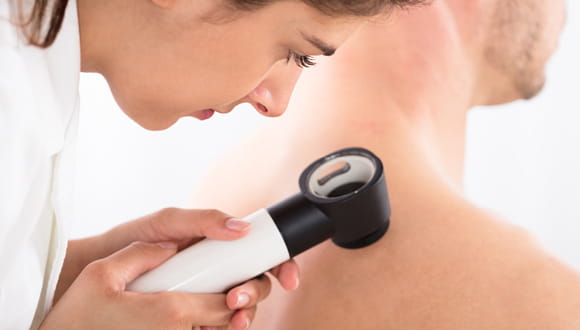Anytime you notice a growth on your skin, your first thought might be: How long has that been there?
But more questions likely follow suit.
Is it a skin tag? A mole? Something else?
Dr. Ming Jih, a dermatologist at Houston Methodist, explains what a skin tag is, how to differentiate one from other types of growths — moles included — and whether you should worry about them.
What is a skin tag?
"A skin tag is a benign growth compromised of normal skin, blood vessels, fat and sometimes fibrous tissue," explains Dr. Jih. "These growths protrude from the skin, often on a stalk or pedicle."
She adds that they're also typically the same color as your skin — they might even look like an extension of it. However, they can be darker than normal skin color. In these cases, they sometimes even look like moles.
Why do skin tags form?
Dr. Jih says that's not entirely clear.
"Skin tags become more common with increasing age, and there may also be a hereditary component to them," says Dr. Jih. "They seem to run in the family."
Skin tags are also associated with metabolic conditions, such as:
- Prediabetes and type 2 diabetes
- Obesity
- Polycystic ovarian syndrome (PCOS)
Skin tags can occur anywhere on the body, but they do seem to predominate in skin folds or in areas of skin that frequently experience friction.
The most common locations for skin tags to develop are the:
- Neck
- Underarms
- Groin area
- Under the breast
- Genitals
- Eyelids
"While friction doesn't cause skin tags, it is a main contributing factor for skin tags to get bigger or irritated," adds Dr. Jih.
Skin tag vs. mole: What's the difference?
Skin tags aren't the only type of growths that can arise on a person's skin.
Moles can, too, and you might wonder how to distinguish between the two.
(Related: When Should You Worry About a Mole?)
"A mole is a collection of melanocytes, which are cells responsible for producing skin color, eye color and hair color," explains Dr. Jih. "One of the primary causes of skin moles is exposure to ultraviolet (UV) radiation from either the sun or man-made sources, like tanning beds."
In many cases, moles are much darker (tan, brown or black) than skin tags — but not always.
"Dermal moles are a particular type of mole that can be flesh-colored and, therefore, look like a skin tag," says Dr. Jih. "But there are some differences that can help distinguish a dermal mole from a skin tag."
For starters, dermal moles tend to be larger and firmer. They also tend to have a wider base and don't protrude in a stalk-like fashion.
"Another distinguishing feature is that dermal moles can form anywhere on the skin, whereas skin tags predominate in the areas previously mentioned," Dr. Jih adds.
Should you be concerned about skin tags?
The good news is that skin tags are benign — aka, noncancerous.
They can, however, be quite bothersome, especially if they're larger or located in certain areas.
For instance, necklaces and clothing may get caught on skin tags on the neck.
"People can also cut or hit a skin tag by accident, causing pain, irritation and sometimes even infection," adds Dr. Jih.
Beyond this, Dr. Jih says that they aren't dangerous — as long as they are indeed skin tags.
"If you're unsure it's a skin tag, we always recommend getting evaluated," says Dr. Jih. "Although rare, other types of growths that are more worrisome, such as basal cell skin cancers, can resemble skin tags in some cases."
A dermatologist can examine the growth and confirm whether it's a skin tag or something else.
How does skin tag removal work?
Skin tags aren't dangerous, so they don't need to be removed.
But, as mentioned, some can become easily irritated and lead to bleeding. Also, some people are bothered by a skin tag's location or appearance.
Fortunately, removing them is a routine procedure for your dermatologist.
"Skin tag removal is a quick office-based procedure," explains Dr. Jih. "Depending on the size, we either freeze or burn the skin tags off or numb the area and cut them off."
Is it safe to remove a skin tag yourself?
Dr. Jih warns against removing skin tags at home.
"Many of my patients ask if they can take them off at home," says Dr. Jih. "I caution against this since there's always the risk of pain, bleeding, incomplete removal and even infection."
She adds that over-the-counter skin tag treatments aren't a good option either.
"They don't work," says Dr. Jih. "All they do is cause irritation, and I've actually seen people have really bad reactions to these products."
Apple cider vinegar — a popular and "natural" home remedy for skin tags — isn't any help either and can actually aggravate the skin to the point that an infection can develop.
"The best way to get rid of skin tags is to visit your dermatologist's office," Dr. Jih adds. "Skin tag removal is a simple in-and-out procedure that carries almost no risk."


